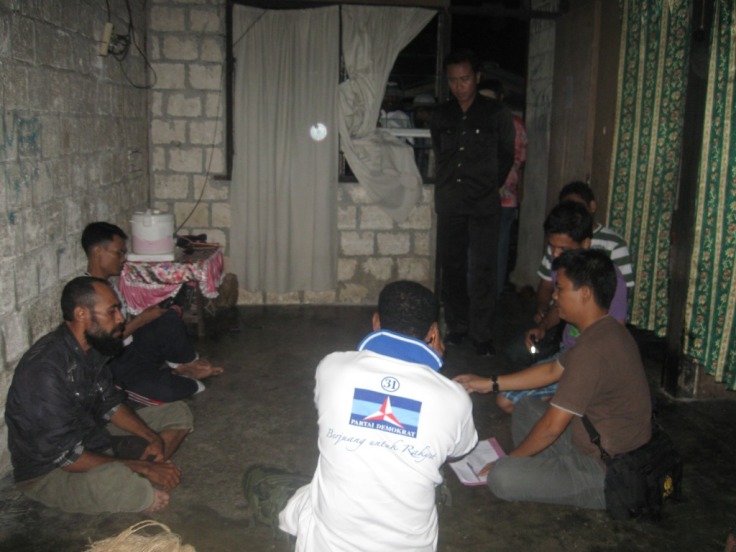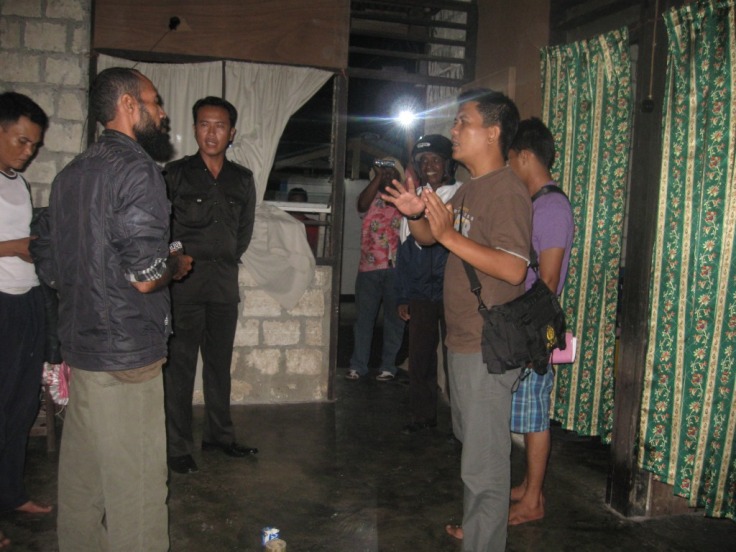December 16, 2013
Key Findings
- 1. The massacre followed a flag-raising led by Filep Karma, an Amnesty International Prisoner of Conscience
Filep Karma testified at the tribunal via prerecorded video since he is currently in prison. He told the tribunal: “In my oratory [at the flag-raising] I said that Papuans must fight peacefully.” “The flag appeared on the top of the tower on July 2, 1998, at about 5:00 a.m. Some seventy-five people gathered beneath it, shouting freedom slogans, singing songs and dancing traditional dances” (Human Rights Watch 1998: 6).
At 2:30 in the afternoon of July 2 “a joint police and military operation attempted to disperse the crowd at the base of the water tower. They launched canisters of tear gas into the crowd with no apparent effect. When a low-ranking police officer, a second-class sergeant, beat an elderly demonstrator named Thonci Wabiser, the crowd spontaneously retaliated, demolishing a truck belonging to Indonesian security forces” (Kirksey 2012: 44). A standoff ensued for days.
- 2. Local and regional officials were involved in the planning of the attack
Tineke Rumakabu testified that two officers of the Indonesian security forces were at the water tower on July 3rd. These commanders—namely Colonel Agus Hedyanto, who was Biak Military Commander (Dandim) and Colonel Johnny Rori, the Biak Police Commander (Kapolres)—negotiated with the crowd and asked that the flag be lowered. These same commanders were later involved in planning the attack. “At 1:00 a.m. on July 4, the local military brought nine village heads together to discuss a strategy for attack, and both the subdistrict head (camat) and the subdistrict military commander told the village heads that each man was responsible for bringing thirty men into the city.” (Human Rights Watch 1998: 8).
Octovianus Mote, former Bureau Chief of the Kompas daily newspaper, gave testimony based on his interviews of regional military and police commanders in July 1998. Major General Amir Sembiring, the Regional Military Commander (Pangdam Trikora), was in a direct command and control position during the attack. According to direct evidence tendered by Mr. Mote to the Tribunal, Sembiring “gave permission to conduct the attack.” Mr. Mote also corroborated reports that Colonel Agus Hedyanto, who was associated with the Special Forces and who served in East Timor, was the key local official involved in Biak. “This was a very well-organized military attack, you know police, navy, and armed forces. All of them organized the attacking of civilians,” continued Mr. Mote. Brigadier General Hotman Siagian, the Regional Police Commander (Kapolda IrJa), was quoted by Antara news agency as saying “the police had ‘tolerated’ the actions of the Biak group since July 2 and finally had to order a crackdown” on July 6th (Prakarsa 1998). Vice Admiral Freddy Numberi, who was then Governor and is currently Indonesia’s Minister of Transportation and Communications, described the victims a members of a “separatist movement that is headed towards treason” (Suara Pembaruan Daily, 8 July 1998). General Wiranto, Commander of Indonesia’s Armed Forces, told reporters when asked about the massacre: “If there is a power that raises a flag, and it is not the Red and White flag [of Indonesia], then this is a betrayal of the military and of the entire nation. This constitutes a betrayal and this is what we must stop!” (Suara Pembaruan Daily, 7 July 1998, punctuation in original).
- 3. Scores of unarmed civilians were killed, buried in mass graves, and dumped at sea
A video testimony, by a woman named “Sarah”, described how the security forces initially surrounded the protestors in a giant letter U. “The military and the police were lined up from the police compound around to the Inpress market. The mobile brigade police (Brimob) that had flown in from Ambon were stationed at the petrol station. Navy troops were down at the harbor.” She describes how they were all shooting, “from four directions,” including the sea.
One woman, who testified to the Tribunal on condition of anonymity, described the first moments of the attack at dawn on July 6th: “The army and police were everywhere. Bullets were raining down. The sky was on fire. We could hear them shooting people at the tower.”
Another witness, who testified under the pseudonym Raymond, described how he rushed to the water tower along with scores of other civilians as the shooting began. After watching as many women and men were gunned down, Raymond was herded with other survivors towards the harbor. He described how he was forced to stare at the sun, kneel in gravel for hours, along with dozens of others.
Sarah gave corroborating testimony: “My family and others were directed down to the harbor…We followed the other families with our hands up over our heads. You could feel the bullets starting to fly over our heads…I could see so many children who had been killed. They were shot on the wharf. They died right there.” Shortly after she arrived at the wharf, she overheard a Sergeant shouting out to the commander of a navy vessel: “Dock the ship! Dock the ship! Carry these people!” She also overheard the reply from the captain: “I cannot dock, the ship is full of bodies.” Sarah said that two ships then went out to sea. “They were there at the harbor in the morning, there to take the bodies away.” Later on “in front of the wharf a blue truck pulled up and took 28 bodies away,” Sarah said. “I was sitting and counting, silently. People who they had shot, they threw their bodies on the truck. Later another container truck came in and took more bodies away. We don’t know where they were taken.”
Ferry Marisan, Director of the human rights organization ELS-HAM Papua, investigated the killings in the weeks after the massacre and was a lead author of the subsequent report, “Names Without Graves, Graves Without Names.” Mr. Marisan described how a fisherman first encountered dead bodies in the sea, off shore of Biak, on July 10th, four days after the massacre: “The fishermen discovered four bodies floating, but these fishermen were scared to take the bodies on shore…The bodies were mutilated, some of them lost their legs or their genitals were not there. They were broken bodies. These bodies were found in the eastern part of Biak, but also in the western part of Biak people found other bodies.” Mr. Marisan also gave direct testimony about a body he helped recover: “Near Biak city, just around the park, we found a female body without a head and genitals that was badly bruised and broken, damaged. Another body we found was just a boy from junior high in his uniform. Most bodies we found were badly damaged. Either they lost their legs, the heads or their genitals.”
- 4. People were beaten, tortured, arbitrarily detained, sexually abused, and executed
Raymond presented testimony about indiscriminate beatings by police at the harbor. He was taken with six truckloads of people to the regional police station (POLRES). Fourteen people were crammed with Raymond into a cell. Raymond was detained for two weeks and in the middle of the night guards routinely doused him with water during his detention.
Statements from Tineke Rumakabu, describe graphic scenes of sexual violence and torture after she was detained by Indonesian forces. Mrs. Rumakabu described how she was tossed into a yellow truck on the morning of July 6, on top of people who were already dead or seriously wounded. She was then taken to the military compound (KODIM). Mrs. Rumakabu showed the Tribunal scars on her arms and described what was done to her while she was blindfolded and cuffed: “They cut my arm with a sharp bayonet and then they poured acid. When I screamed they burnt me with cigarettes.”
The blindfold was later removed and she was stripped naked in a room with twelve other women and girls. “Then I saw a man [a soldier] showing me a little knife, the one that you use to shave, and he said ‘We are going to use this to cut off your vaginas, from above and below, and from the left to the right.’” “I saw a little girl and they raped her and she died,” Mrs. Rumakabu told the Tribunal. “All over the place it was blood everywhere because women, their vaginas and clitoris’ had been cut out, and they had been raped many, many times.” One of the women in detention, Marta Dimara was a friend of Mrs. Rumakabu. “Martha said, ‘I would rather be killed than you rape me.’ They put a bayonet in her neck and then her vagina and also cut off her breasts and beheaded her.” Mrs. Rumakabu told the Tribunal: “I was also tortured, a lit candle was penetrated inside me, they cut off my clitoris and they raped me.” Out of the twelve women in detention with her, she reported: “Eight women were killed and four of us stayed alive.”
- 5. Weaponry and equipment from international donors was used
At least two Navy ships were involved in the attack:
KRI Teluk Berau (534), Type 108. Source: Human Rights Watch Report, page 9 and corroborated by Eben Kirksey in a 2003 interview with an eyewitness. This ship belonged to the former German Democratic Republic (East Germany) and was manufactured in 1977 by VEB Peenewerft in Wolgast. It was purchased, along with 12 other units of the same type, by the Indonesian Navy and transferred on August 25th 1993. Formerly named the GDR Eberswalde-Finow (634), this ship was 90.7 meters long and weighed 1,900 tons. It was used as an amphibious landing ship by the Indonesian marines (Marinir TNI AL). The KRI Teluk Berau was armed with “a double barrel cannon with a caliber of 37 millimeters, a Bofors 40mm anti-aircraft gun and multipurpose autocannon, and two double barrel cannons with a caliber of 25 millimeters.” (Source: Koramatim 2012)[i]
KRI Kakap (811), Source: Eben Kirksey’s photograph from July 6th, 1998.
The KRI Kakap-811 is a Fast Patrol Boat that was manufactured by PT. Pal Indonesia and has been in service since 1988. It is armed with a Bofors 40mm and 20mm anti-aircraft guns and multipurpose autocannons as well as 12.7 mm machine guns. This ship can carry one helicopter (Source: Koramatim 2013).
Sources Cited
Human Rights Watch (1998) “Indonesia: Human Rights and Pro-Independence Actions in Irian Jaya” Vol 10, No. 8 (C)
Kirksey, Eben (2013) Freedom in Entangled Worlds: West Papua and the Global Architecture of Power (Durham: Duke University Press).
Koarmatim (2012) “KRI Teluk Berau-534 Mengakhiri Pengabdiannya,” Available on-line: http://koarmatim.tnial.mil.id. Updated: 28 September, 2012, 11:34. Accessed: 12 November, 2013, 12:53
Koarmatim (2013) “KRI Kakap-811 Siap Amankan Perairan Perbatasan RI-Philipina,” Available on-line: http://koarmatim.tnial.mil.id. Updated: 11 November, 2013, 13:51. Accessed: 25 November, 2013, 23:18.
Prakarsa, Patrisia (1998) “Indonesian Troops Wound 24 in Irian Jaya Shooting” Agence France Presse, July 6.
Suara Pembaruan Daily (1998) “Menhankam/Pangab Jenderal TNI Wiranto: Pengibaran Bendera Bukan Merah-Putih Tindakan Makar” Suara Pembaruan Daily, 7 July.
Suara Pembaruan Daily (1998) “Akibat Kerusuhan di Irja” Suara Pembaruan Daily, 8 July.
Related articles
- West Papua massacre: Sydney University ‘tribunal’ demands Biak slaughter probe (pacific.scoop.co.nz)
- Citizen’s tribunal calls on Indonesia to investigate Biak massacre (abc.net.au)
- Sydney University Going to Release Findings Biak Bloody Tragedy (thevoiceofwestpapua.wordpress.com)
- West Papuans tortured, killed and dumped at sea (pacific.scoop.co.nz)
- Groups Urge Justice on 15th Anniversary of Biak Massacre (pacific.scoop.co.nz)
- The Biak Massacre – A Citizens Tribunal 6 July 1998 – 6 July 2013 (yasons.wordpress.com)
- Seeking justice: Citizens tribunal on the Biak massacre (asopa.typepad.com)
- Insos story, July 6, 1998 in Biak (netarumtelebe.wordpress.com)
- West Papuans Arrested for Organising Welcoming Procession (freedomflotillawestpapua.org)
- West Papua is Indonesia’s Palestine (fairobserver.com)















